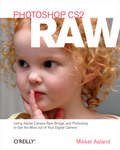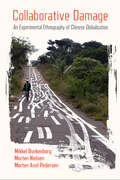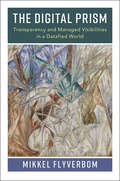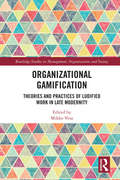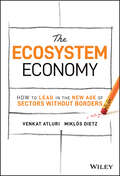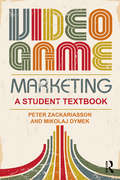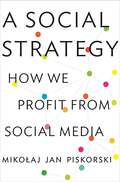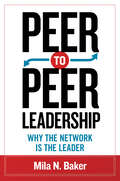- Table View
- List View
Photoshop CS2 RAW
by Mikkel AalandThe RAW file format is the uncompressed data file captured by a digital camera's electronic sensor. When your camera saves an image in RAW format, settings like white balance, sharpening, contrast and saturation are not applied to the image but are saved instead in a separate header. Because RAW files remain virtually untouched by in-camera processing, they are essentially the digital equivalent to exposed but undeveloped film. This makes RAW an increasingly popular format with amateur and professional digital photographers, because it affords greater flexibility and control during the editing process-if you know how to work with RAW files. Most digital camera manufacturers supply their own software for converting RAW data, as do some third party vendors. Increasingly, however, the RAW converter of choice is a plug-in included in the latest version of Adobe Photoshop, the most popular and widely-used digital image editing tool in the world. Adobe Photoshop CS2 is emerging as the best place to edit RAW images, and the best way to master this new format is with Photoshop CS2 RAW. An important book dedicated to working with RAW in Photoshop, this comprehensive guide features a unique design that helps readers grasp the subject through visual instruction and prompts. The entire RAW process is explored, from shooting to using the Adobe plug-in converter and new Bridge navigation software. The primary focus of Photoshop RAW is, as the title suggests, Photoshop editing technique: automating RAW workflow, correcting exposures, extending exposure range, manipulating grayscale and working with the new DNG (Digital Negative) open standard that Adobe supports. Presented by photographer Mikkel Aaland, a pioneer of digital photography and author of eight books, including O'Reilly's Photoshop for the Web and the award-winning Shooting Digital, Photoshop CS2 RAW investigates and instructs in an accessible visual style. Required reading for professionals and dedicated photo hobbyists alike.
Collaborative Damage: An Experimental Ethnography of Chinese Globalization
by Morten Axel Pedersen Morten Nielsen Mikkel BunkenborgCollaborative Damage is an experimental ethnography of Chinese globalization that compares data from two frontlines of China's global intervention—sub-Saharan Africa and Inner/Central Asia. Based on their fieldwork on Chinese infrastructure and resource-extraction projects in Mozambique and Mongolia, Mikkel Bunkenborg, Morten Nielsen, and Morten Axel Pedersen provide new empirical insights into neocolonialism and Sinophobia in the Global South.The core argument in Collaborative Damage is that the different participants studied in the globalization processes—local workers and cadres; Chinese managers and entrepreneurs; and the authors themselves, three Danish anthropologists—are intimately linked in paradoxical partnerships of mutual incomprehension. The authors call this "collaborative damage," which crucially refers not only to the misunderstandings and conflicts they observed in the field, but also to their own failure to agree about how to interpret the data. Via in-depth case studies and tragicomical tales of friendship, antagonism, irresolvable differences, and carefully maintained indifferences across disparate Sino-local worlds in Africa and Asia, Collaborative Damage tells a wide-ranging story of Chinese globalization in the twenty-first century.
The Digital Prism: Transparency and Managed Visibilities in a Datafied World
by Mikkel FlyverbomMany people are concerned about the unchecked powers of tech giants and the hidden operations of big data and algorithms. Yet we do not have the vocabularies to properly articulate how these digital transformations shape our lives. This book shows how the management of visibilities - our digital footprints - is a central force in the digital transformation of societies and politics. Seen through the prism of digital technologies and data, the lives of people and structuring of organizations take new shapes in our understanding. Making sense of these requires that we push beyond common ways of thinking about transparency and surveillance, and look at how managing visibilities is a central but overlooked force that influences how people live, how organizations work and how societies and politics operate.
Nordic Criminal Justice in a Global Context: Practices and Promotion of Exceptionalism (Nordic Studies in a Global Context)
by Mikkel Jarle Christensen, Kjersti Lohne and Magnus HörnqvistThis book critically investigates Nordic criminal justice as a global role model. Not taking this role for granted, the chapters of the book analyse how Nordic approaches to criminal justice were folded into global contexts, and how patterns of promotion were built around perceptions that these approaches also had a particular value for other criminal justice systems. Specific actors, both internal and external to the region itself, have branded Nordic criminal justice as a form of ‘penal exceptionalism’ associated with human rights, universalistic welfare and social cohesion. The book shows how building and using the brand of Nordic criminal justice allowed stakeholders to champion specific forms of crime control across a variety of criminal justice areas in both domestic and international settings. The book will be of interest to scholars and students of criminal justice, international law and justice, Nordic and Scandinavian studies, and more widely to the social sciences and humanities.
Intellectual History of Economic Normativities
by Mikkel ThorupThe book investigates the many ways thateconomic and moral reasoning interact, overlap and conflict both historicallyand at present. The book explores economic and moral thinking as a historicallycontingent pair using the concept of economic normativities. The contributorsuse case studies including economic practices, such as trade and finance andtax and famine reforms in the British colonies to explore the intellectualhistory of how economic and moral issues interrelate.
Socionomics: How Social Mood Shapes Society
by Mikko KetovuoriSocionomics: How Social Mood Shapes Society explores the main principles and applications of socionomic theory as elaborated by Robert Prechter. Socionomic theory posits that an omnipresent social mood, shifting constantly in a wave form through all aspects of society, is responsible for the aggregate tenor and character of all social, economic and cultural trends, from fluctuations in the stock market to the popularity of particular genres of music at a given time.The social mood as an endogenous and collective force has its roots in the herding instinct often identified amongst crowds. Individuals typically make rational decisions when acting alone, and in the context of certainty, but in groups and in context of uncertainty, mood-based mimetic behavior can affect all the participants. As social mood often goes unnoticed, people tend to give their collective feelings labels to rationalize them, thus constituting ‘public opinion’. Therefore, whilst ‘public opinion’ as presented in the media is usually seen as rational, it is in fact based on the social mood context that often determines how people think, feel and behave. As the internet and social media have become ubiquitous in our daily lives, these rationalizations are spreading faster and faster than ever before and creating a pseudo-reality which can corrupt the collective perception of what is real and what is not.This stimulating and thought-provoking book will be of great interest to academics, practitioners and policymakers with an interest in the humanities and social sciences, particularly sociology and economics.
Drag as Marketplace: Contemporary Cultures, Identities and Business
by Mikko Laamanen, Mario Campana, Maria Rita Micheli, Rohan Venkatraman and Katherine DuffyToday drag has an unprecedented mass cultural appeal. Reaching far beyond traditional queer venues and audiences into the mainstream, it has evolved into a booming industry worth millions of dollars. Drag is art, politics, lifestyle and entertainment all in one. Yet, studies examining its market value as a product, brand or consumption practice remain scarce. This interdisciplinary collection fills that void, exploring the intersection of drag and markets. Written by an international group of scholars exploring cases from Europe, Asia and the US, this will be a key resource for anyone curious about drag’s social, political and economic impact.
Organizational Gamification: Theories and Practices of Ludified Work in Late Modernity (Routledge Studies in Management, Organizations and Society)
by Mikko VesaThis edited volume presents an interdisciplinary collection of texts that examine the practice of gamification, the use of game design elements in non-game contexts, specifically as an organization and management research problem. As we travel deeper into the twenty-first century, it is becoming increasingly clear the late modernity is re defining its take on games and play. Following what has been termed a general ludification or playification of society, corporations are beginning to see games and play as resources rather than as a wasteful practice. We are witnessing the emergence of the practice of gamificiation with the intention of mobilizing play’s motivational power for capitalist production. This book outlines both the essential "how tos" and also critically explores their links to diverse strands of organization theory such as institutionalism, business ethics, critical theory and organizational behavior. Gamification research has been mostly conducted within disciplines such as information studies, game studies and information systems science. This is a paradoxical state of affairs; whilst gamification aims at being a transformative intervention in work processes and practices and is being deployed as such by practitioners. This book will be of value to researchers, academics and students interested in management and organization studies.
The Ecosystem Economy: How to Lead in the New Age of Sectors Without Borders
by Venkat Atluri Miklós DietzGear up and equip your organization for an entirely new competitive landscape In The Ecosystem Economy: How to Lead in the New Age of Sectors Without Borders, two McKinsey & Company senior partners offer an incisive and eye-opening look at the emerging ecosystem economy and what it means for companies used to familiar sector siloes. In the book, you&’ll explore how the most successful companies in the new economy aren&’t the ones that have applied old-school best practices but, instead, have adopted entirely new mindsets and approaches for a fundamentally transforming market. You&’ll also find: Explanations of why it&’s so important for companies to adopt a new approach in the face of a foundationally changing economy (and what they stand to gain) How the new ecosystem economy will continue to evolve and change, dissolving the borders between the traditional sectors of the economy A comprehensive ecosystem playbook that can be applied to firms of any size and in any sector As the barriers between sectors and disciplines come down, organizations everywhere will need to reshape their thinking about value propositions, competition, partnership, organizational and operating models, and performance management. The Ecosystem Economy is your personal roadmap to navigating that new world. It&’s ideal for managers, executives, and other business leaders seeking fresh new strategies and practical approaches for markets that bear little resemblance to the ones that came before.
Gurus and Oracles
by Miklos SarvaryWe live in an "Information Age" of overabundant data and lightning-fast transmission. Yet although information and knowledge represent key factors in most economic decisions, we often forget that data, information, and knowledge are products created and traded within the knowledge economy. In Gurus and Oracles, Miklos Sarvary describes the information industry--the far-flung universe of companies whose core business is to sell information to decision makers. These companies include such long-established firms as Thomson Reuters (which began in 1850 with carrier pigeons relaying stock market news) as well as newer, dominant players like Google and Facebook. Sarvary highlights the special characteristics of information and knowledge and analyzes the unusual behaviors of the markets for them. He shows how technology contributes to the spectacular growth of this sector and how new markets for information change our economic environment. Research in economics, business strategy, and marketing has shown that information is different from other goods and services; this is especially true in competitive settings and may result in strange competitive market outcomes. For example, Sarvary points out, unreliable information may be more expensive than reliable information; information sellers may be better off inviting competitors into their market because this may allow them to increase their prices; and competition may lead to increased media bias--but this may benefit consumers who want to discover the truth. In Gurus and Oracles, Sarvary explores the implications of these and other peculiarities for information buyers and sellers.
Gurus and Oracles: The Marketing of Information
by Miklos SarvaryAn examination of the information industry, from Reuters to Facebook, and the special characteristics of information and knowledge markets.We live in an “Information Age” of overabundant data and lightning-fast transmission. Yet although information and knowledge represent key factors in most economic decisions, we often forget that data, information, and knowledge are products created and traded within the knowledge economy. In Gurus and Oracles, Miklos Sarvary describes the information industry—the far-flung universe of companies whose core business is to sell information to decision makers. These companies include such long-established firms as Thomson Reuters (which began in 1850 with carrier pigeons relaying stock market news) as well as newer, dominant players like Google and Facebook. Sarvary highlights the special characteristics of information and knowledge and analyzes the unusual behaviors of the markets for them. He shows how technology contributes to the spectacular growth of this sector and how new markets for information change our economic environment.Research in economics, business strategy, and marketing has shown that information is different from other goods and services; this is especially true in competitive settings and may result in strange competitive market outcomes. For example, Sarvary points out, unreliable information may be more expensive than reliable information; information sellers may be better off inviting competitors into their market because this may allow them to increase their prices; and competition may lead to increased media bias—but this may benefit consumers who want to discover the truth. In Gurus and Oracles, Sarvary explores the implications of these and other peculiarities for information buyers and sellers.
Electronic Technology and Civil Procedure
by Zoltán Nemessányi Miklós KengyelThe effect of modern and communication technology on civil procedure first appeared on the agenda of the conference organized by the International Association of Procedural Law in 1999, verifying Lord Woolf's statement from the 90's, that "IT will not only assist in streamlining and improving our existing systems and process; it is also likely, in due course, itself to be catalyst for radical change as well...". At the conference in Pecs in the autumn of 2010 participants from three continents and twenty-five countries examined all aspects of the impact of modern information technology on civil procedure beginning with the electronic submission of the application, ranging from electronic service of documents and electronic means of proof supported by modern information technology. In addition to the practical issues they discussed the possible impact of electronic procedures on traditional principles of civil procedure. The conference book contains seven main reports and eleven correferates, the foreword was written by Prof. Peter Gottwald, the President of the International Association of Procedural Law.
Miss Jessie's
by Miko BranchMiss Jessie's is a memoir and business guide rich with inspirational life lessons and unique business advice from Miko Branch, the Chief Executive Officer of the dynamic Miss Jessie's--the company that revolutionized the hair-care industry.When Miko and her sister, Titi, were children, their grandmother Miss Jessie taught them independence and showed them the value of being "do it yourself" women, all while whipping up homemade hair concoctions at her kitchen table. As a co-founder of Miss Jessie's, Miko reveals how she and Titi applied their grandmother's lessons to create a successful business from scratch. Miss Jessie's chronicles the Branch sisters' remarkable story. When they were children, their stern father encouraged them to become self-reliant and not to depend on their looks to get ahead. Taking this message to heart, they blossomed into business owners and leaders in their field, using ingenuity and without borrowing a dime. They soaked up the entrepreneurial and creative culture of the early hip-hop era on the streets of Brooklyn in the late 1990s, and in the high-end salons of Manhattan. They blended these inspirations to establish a business that has gone from their kitchen table to the shelves of major retailers around the globe, revolutionizing the hair-care industry. A charming and enlightening look at the women behind the brand, Miss Jessie's is chock-full of entertaining stories and invaluable instruction that can be applied to any business: an authentic expression that the American Dream is possible.
Building Business Websites with Squarespace 7
by Miko Coffey<P><P>Master the tools and techniques of using Squarespace to create professional websites <P><P>About This Book <P><P>Use all of the Squarespace functions to design, build, launch, and analyze your website <P><P>Employ this step-by-step, approach to discover the best process for building websites with Squarespace, including tips and advice specifically for businesses <P><P>Discover how to tailor Squarespace templates and functions to your business needs, whether it's an information site, online portfolio, or e-commerce store <P><P>Who This Book Is For <P><P>This book is ideal for anyone who wants to learn how to use the latest version of Squarespace to create a website from scratch and take it through to go-live. You don't need any prior experience with Squarespace, HTML or CSS, or building websites in general as everything is done using Squarespace's simple, browser-based interface. <P><P>What You Will Learn <P><P>Create your website framework, fill it with content, and arrange your pages using Squarespace's drag and drop layout tools <P><P>Customize your site's look and feel to match your brand, and create stunning visual impact, even on mobile and tablet devices <P><P>Configure the core functions your business needs such as sharing to social media, showcasing your work, or selling goods and services online <P><P>Discover time-saving tricks and how to avoid common pitfalls from an experienced professional with years of Squarespace experience <P><P>Gain valuable insights about search engine optimization and other e-marketing advice beyond just how to build a website <P><P>Understand how to monitor, measure, and manage your website post-launch <P><P>Develop an essential Website Toolkit that will act as reference material for your entire project, ensuring you stay on target to meet your objectives <P><P>In Detail <P><P>This practical guide walks you through the various steps involved in building a website for your business with Squarespace. You will learn how to use all of the tools provided by Squarespace to control the layout, appearance, structure, and functions of your website, starting from the inception stage, all the way to monitoring your site after it has been launched. <P><P>This is much more than just a how-to book for the Squarespace system: it's filled with helpful advice that will help you improve your website's visibility in search engines and tailor your site for your customers. Moreover, it provides dozens of other business-oriented tips to help your website stand out from the crowd. If you have used Squarespace 5 or other website builders/CMSes, this book will help you understand the key differences and teach you how to do things based on the new features of Squarespace 7.
The Business of Gamification: A Critical Analysis (Routledge Advances in Management and Business Studies)
by Peter Zackariasson Mikolaj DymekAt the turn of the century the term "gamification" was introduced as a concept to understand the process of using game mechanics in "non-game" contexts. The impact of gamification was soon evident to business practices where it had impact both on marketing and, more broadly, on the organizations themselves. As the number of individuals playing video games grows, there seem to be an acceptance of game mechanics elsewhere. Its effectiveness is highly dependent on both technical possibilities and cultural acceptance, two factors present today. The aim of The Business of Gamification is to critically analyze the practical and theoretical consequences of gamification. Practically, how has gamification been applied in businesses to this point, and what are the future scenarios? Theoretically, what are the contributions of gamification to existing academic knowledge? How does this change our understanding of how business are performing and its consequences, for organizations, consumers, and society in general? This edited volume contains new, and stringent, perspectives on how gamification is contextualized in business settings, both in theory as well as in practice. This book will provide a wealth of research for individuals seriously interested in the industry at the academic level. As a result, this book will serve as a reference in curricula associated with video game development for years to come.
Video Game Marketing: A student textbook
by Peter Zackariasson Mikolaj DymekThe video game industry has been one of the fastest-growing cultural phenomena of our times with market conditions that demand a specific skill set from its marketers. To a new generation of "indie gamers", being a game developer isn’t just about design and production, a successful video game demands entrepreneurial skills and astute business acumen. The creators need to know what their customers want, how to reach those customers and how to sell to them. Video Game Marketing: A student textbook is for development students or aspiring developers who want to know how to promote and sell the results of their efforts. This book is a much-needed guide to: • the essentials of marketing strategy; • video games as products or services; • marketing research for game development; • branding video games; • marketing through game: gamification, advergames. Replete with pedagogy to aid learning such as objectives and discussion questions for each chapter, this book is all that aspiring video game developers will need to unleash the potential of their games.
A Social Strategy: How We Profit from Social Media
by Mikolaj Jan PiskorskiWhat people get out of social media—and how businesses can get more out of itAlmost no one had heard of social media a decade ago, but today websites such as Facebook, Twitter, and LinkedIn have more than 1 billion users and account for almost 25 percent of Internet use. Practically overnight, social media seems indispensable to our lives—from friendship and dating to news and business.What makes social media so different from traditional media? Answering that question is the key to making social media work for any business, argues Miko?aj Piskorski, one of the world's leading experts on the business of social media. In A Social Strategy, he provides the most convincing answer yet, one backed by original research, data, and case studies from companies such as Nike and American Express.Drawing on his analysis of proprietary data from social media sites, Piskorski argues that the secret of successful ones is that they allow people to fulfill social needs that either can’t be met offline or can be met only at much greater cost. This insight provides the key to how companies can leverage social platforms to create a sustainable competitive advantage. Companies need to help people interact with each other before they will promote products to their friends or help companies in other ways. Done right, a company’s social media should benefit customers and the firm. Piskorski calls this "a social strategy," and he describes how companies such as Yelp and Zynga have done it.Groundbreaking and important, A Social Strategy provides not only a story- and data-driven explanation for the explosion of social media but also an invaluable, concrete road map for any company that wants to tap the marketing potential of this remarkable phenomenon.
Choosing Corporate and Global Scope
by Mikolaj Jan PiskorskiIntroduces students to the study of corporate strategy, while providing an overview framework for understanding international strategy. Focuses on questions of scope and ownership. Examines both horizontal and vertical integration. Underscores the point that economies of scope, or the existence of relationship-specific investments, are insufficient to explain effective corporate strategy unless there are important obstacles to contractual solutions.
LinkedIn (A)
by Mikolaj Jan PiskorskiIn the summer of 2005, LinkedIn, a two-year-old start-up, was choosing between two options to monetize its 5 million business people network. Members could contact each other through trusted intermediaries on the network to offer or seek jobs, consulting engagements, expertise, and financing. The company had outpaced its competitors by building the most populous online business network, but it had little revenue to show its investors. The first revenue option entailed keeping the existing features unchanged and rolling out a bundle of eight new services for a monthly fee of $15. These services would be targeted at network members who had forged many connections, logged in frequently, and viewed the profiles of many other members. The second proposal involved changing a basic design feature of LinkedIn by allowing members to contact each other without intermediaries for a fee. Fewer members would avail themselves of this feature, but those who did would be willing to pay as much as $5-$15 per message. This option ran a substantial risk of alienating members and would prompt some to abandon LinkedIn.
Note on Corporate Strategy
by Mikolaj Jan PiskorskiIntroduces students to the study of corporate strategy. Focuses on questions of scope and ownership. Examines both horizontal and vertical integration. Underscores the point that economies of scope, or the existence of relationship-specific investments, are insufficient to explain effective corporate strategy unless there are important obstacles to contractual solutions.
Social Strategy at Nike
by Mikolaj Jan Piskorski Ryan JohnsonNike, which first started experimenting with social media and networking in 2004, has been consistently reducing its spending on traditional advertising. Yet, Nike has not pulled back on its overall marketing budget, instead opting to focus on "nontraditional" advertising through new mediums. In doing so, the team hoped to build online communities to foster a closer relationship with its consumers. By 2012 Nike had committed to a social strategy that linked product with experience. Soon the company will discover if this strategic jump will be reflected on the bottom line.
Peer-to-Peer Leadership: Why the Network Is the Leader
by Mila N. BakerOur leadership models are stuck in an Industrial Age, top-down mentality. But in our complex, data-drenched, 24/7 world, there is simply too much information coming from too many different directions too quickly for any one leader or group to stay on top of it. Hierarchy is breaking down everywhere—why should leadership be any different? Inspired by the peer-to-peer model of computing used in social networking and crowdsource technologies, Mila Baker shows a new way to lead. Organizations, she says, must become networks of "equipotent" nodes of power—peer leaders. The job of the leader is now to set the overall goals and direction and optimize the health of that network, not tell it what to do. In these organizations, leadership roles shift rapidly to fit the needs of any given situation. Information flows freely so those who need it can find it easily and act on it immediately. Feedback becomes an organic part of the workflow, enabling rapid course corrections. Baker shows how companies like Gore and Herman Miller have achieved long-term success practicing these principles and provides a structure that any organization can adapt to build flexibility, resiliency, and accountability.
Designing Smart Prices: Kundenwahrnehmung von Dynamic und Personalized Pricing (Beiträge zur empirischen Marketing- und Vertriebsforschung)
by Mila VogelsangDie intelligente, algorithmenbasierte Preisgestaltung, das sogenannte Smart Pricing, ist zu einer wichtigen Säule bei der Entwicklung neuer Preisstrategien geworden. Sowohl die Praxis als auch wissenschaftliche Studien indizieren, dass diese Form der Preisgestaltung zu einer signifikanten Umsatz- und Gewinnsteigerung beitragen kann. Diese Buch leistet sowohl in theoretischer als auch in praktischer Hinsicht ein tiefergehendes Verständnis für Smart Pricing, im Speziellen Dynamic und Personalized Pricing, und zeigt wichtige Erklärungs- und Lösungsansätze auf, wie diese innovativen Preisstrategien systematisch gestaltet werden sollten.
Milady's Standard: Nail Technology
by MiladyThis latest edition of Milady's Standard Nail Technology contains new and updated information on many subjects including infection control, product chemistry, manicuring, pedicuring, electric filing, monomer liquid and polymer powder nail enhancements and UV gels. Also included is a completely new chapter, The Creative Touch, loaded with the latest nail art mediums and techniques to enhance the learner's experience. In order to make for easier implementation, select editorial content from Milady's Standard Nail Technology and Milady's Standard Cosmetology have been aligned. This new format makes this the most complete resource for students to kick off their nail technology careers. Also included are brand new photographs and art that depict nail technicians performing their work and serving their clients encompassed by more than 400 pieces of art throughout the book, including procedural art.
